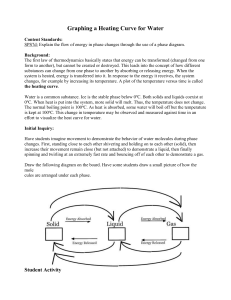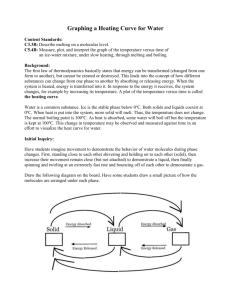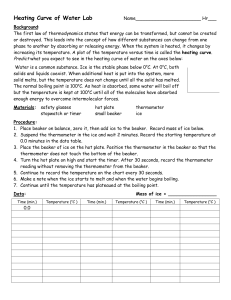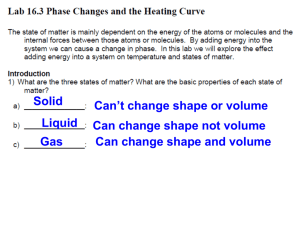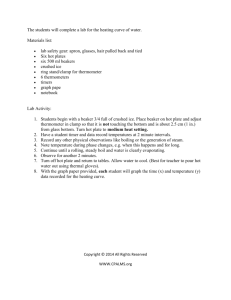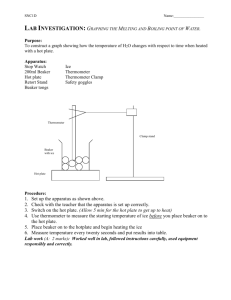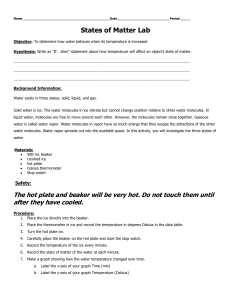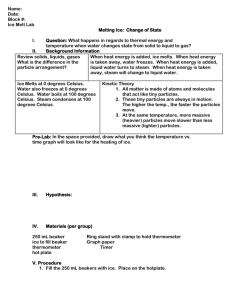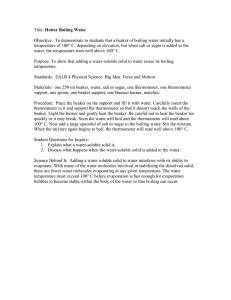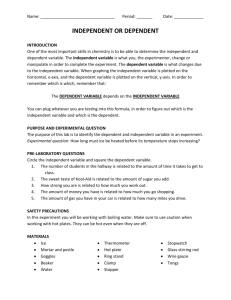Chemistry Lab
advertisement
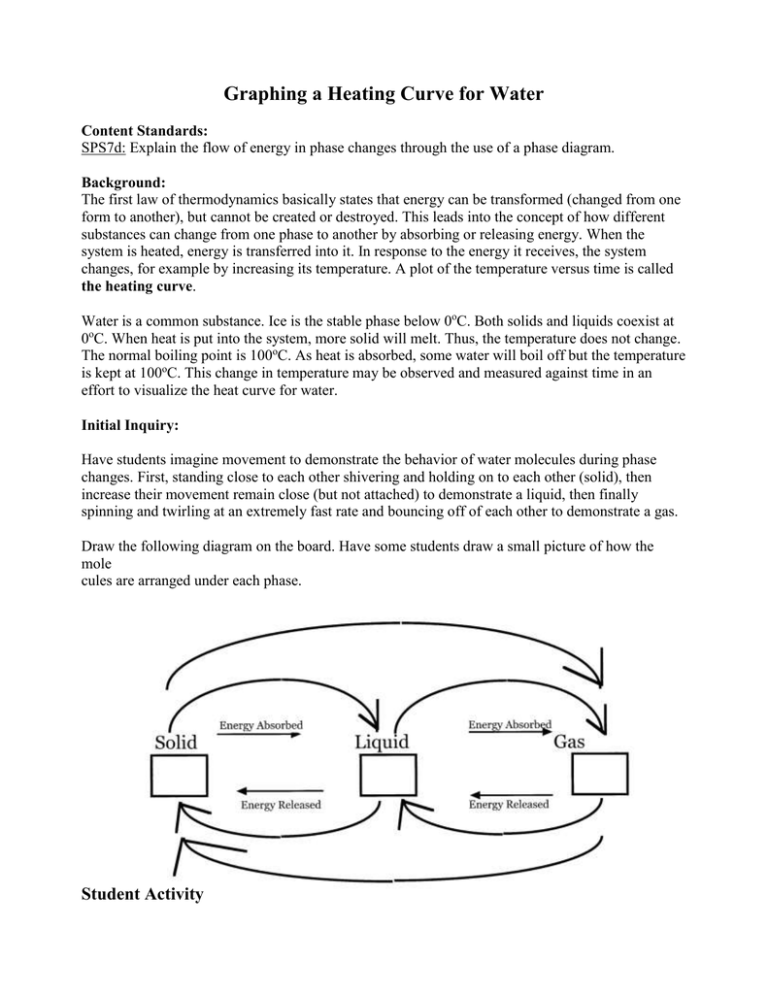
Graphing a Heating Curve for Water Content Standards: SPS7d: Explain the flow of energy in phase changes through the use of a phase diagram. Background: The first law of thermodynamics basically states that energy can be transformed (changed from one form to another), but cannot be created or destroyed. This leads into the concept of how different substances can change from one phase to another by absorbing or releasing energy. When the system is heated, energy is transferred into it. In response to the energy it receives, the system changes, for example by increasing its temperature. A plot of the temperature versus time is called the heating curve. Water is a common substance. Ice is the stable phase below 0oC. Both solids and liquids coexist at 0oC. When heat is put into the system, more solid will melt. Thus, the temperature does not change. The normal boiling point is 100oC. As heat is absorbed, some water will boil off but the temperature is kept at 100oC. This change in temperature may be observed and measured against time in an effort to visualize the heat curve for water. Initial Inquiry: Have students imagine movement to demonstrate the behavior of water molecules during phase changes. First, standing close to each other shivering and holding on to each other (solid), then increase their movement remain close (but not attached) to demonstrate a liquid, then finally spinning and twirling at an extremely fast rate and bouncing off of each other to demonstrate a gas. Draw the following diagram on the board. Have some students draw a small picture of how the mole cules are arranged under each phase. Student Activity Materials: safety glasses lab coat or apron stopwatch or timer hot plate small beaker ice thermometer plastic thermometer clamp graph paper Procedure: 1. Put on safety goggles and lab coat or apron. 2. Use the data chart provided to record time and temperature. The time column starts with 0. The temperature column is blank. You will record the temperatures in the temperature column during the investigation. 3. Fill the small beaker with ice. Insert the thermometer. Wait 2 minutes. Observe and record the starting temperature (0 time) in the data table. 4. Place the beaker of ice on the hot plate. Position the thermometer in the clamp so that the bulb of the thermometer does not touch the bottom of the beaker. 5. Turn the hot plate on high and start the timer. After 30 seconds, record the thermometer reading without removing the thermometer from the beaker. (DO NOT TOUCH THE HOT PLATE!!!!!!) 6. Continue to record the temperature on the chart every 30 seconds. 7. Make a note when the ice has melted and when the water begins boiling. Analysis: Write your data in the following table: Time Temperature Prepare a graph from your data that includes the following information: 1. Label the x-axis with the time (in minutes). This is your independent variable. Label the yaxis as temperature (in degrees Celsius). This is your dependent variable. 2. Plot your points using your recorded data. 3. Label the 5 areas on your graph: solid (S), liquid (L), gas (G), freezing point/melting point FP/MP and condensation/boiling point (CP/BP). 4. Trace, with colored pencils, the following parts of the line on your graph: slowest molecular motion (in red), fastest molecular motion (in green). 5. DON’T FORGET TO TITLE YOUR GRAPH!!!!!!!! 6. You graph should look like stair steps not a straight line. Conclusions Explain what is happening to the water molecules in the flat areas of the line on your graph during the phase changes from solid to liquid and liquid to gas. When the ice is melting is it releasing heat or absorbing heat? Explain your answer. If you put the liquid water into the freezer and recorded its temperature as it refroze, would it be absorbing heat or releasing heat? Explain your answer. Explore Further (for extra credit). Research what is occurring when you have a fever. What part does water play in regulating your body temperature? What happens to the chemical bonds of enzymes when exposed to too much heat? Phase Change Worksheet The graph was drawn from data collected as a substance was heated at a constant rate. Use the graph to answer the following questions. At point A, the beginning of observations, the substance exists in a solid state. Material in this phase has _______________ volume and _____________ shape. With each passing minute, _____________ is added to the substance. This causes the molecules of the substance to ____________ more rapidly which we detect by a ________________ rise in the substance. At point B, the temperature of the substance is ______°C. The solid begins to __________. At point C, the substance is completely ____________ or in a ___________ state. Material in this phase has _______________ volume and _____________ shape. The energy put to the substance between minutes 5 and 9 was used to convert the substance from a ___________ to a ___________. Between 9 and 13 minutes, the added energy increases the ______________ of the substance. During the time from point D to point E, the liquid is ___________. By point E, the substance is completely in the __________ phase. Material in this phase has _____________ volume and ___________ shape. The energy put to the substance between minutes 13 and 18 converted the substance from a ___________ to a ___________ state. Beyond point E, the substance is still in the ______________ phase, but the molecules are moving _______________ as indicated by the increasing temperature. Taken From: http://www.galaxynet.com/~corvid/psc/psca_phase_change_worksht.htm
